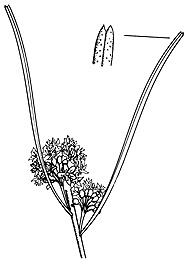Common name: Toothed Phebalium
Leionema dentatum (Sm.) Paul G.Wilson APNI* Synonyms: Phebalium dentatum Sm. APNI*

Description: Shrub or small tree to 6 m high; stems ± terete.
Leaves linear to narrow-oblong to narrow-elliptic or oblanceolate, 4–8 cm long, 1–8 mm wide, smooth, apex truncate to retuse and 2-toothed, margins recurved to revolute or ± toothed, lower surface white stellate-hairy with midrib prominent.
Cymes axillary, c. 10-flowered; peduncle angled, 2–8 mm long; pedicels slender, c. 4 mm long. Calyx lobes broad-triangular, fleshy. Petals c. 3.5 mm long, pale yellow to white, gland-dotted, glabrous.
Cocci erect, c. 3.5 mm long, outer angle shortly apiculate.
Flowering: spring.
Distribution and occurrence: Grows in dry sclerophyll forest on sandstone; chiefly on the ranges from Gibraltar Range National Park to the Illawarra region.
NSW subdivisions: CC, SC, NT, CT
Plants from the Gibraltar Range (Northern Tablelands) are geographically isolated and have broader leaves with smoother margins than southern populations (south from Central Coast and Tablelands). Research is required to determine if this variation warrants taxonomic recognition.
Text by P.H. Weston & G.J. Harden
Taxon concept: Flora of NSW 2 (1991)
APNI* Provides a link to the Australian Plant Name Index (hosted by the Australian National Botanic Gardens) for comprehensive bibliographic data
***The AVH map option provides a detailed interactive Australia wide distribution map drawn from collections held by all major Australian herbaria participating in the Australian Virtual Herbarium project.
|


